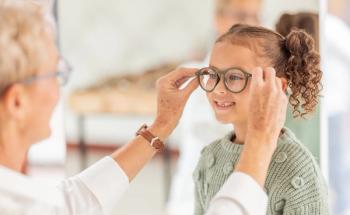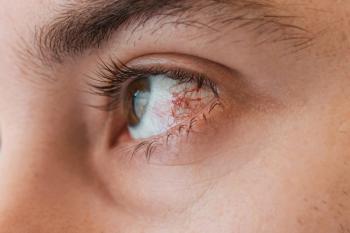
- Vol. 11 No.7
- Volume 11
- Issue 7
9 simple solutions to 9 complex cases
The specialty lens-fitting optometrist has a variety of lenses in the arsenal to choose from for the simplest to the most complex patient. Armed with patient goals in mind, increasing options can push ODs to aim for the “troubleshooting” tool without a reason to consider the simpler solution.
Many times customized gas permeable (GP) lenses or scleral lenses are the only fix, but taking a step back can yield a creative solution using standard designs. This article will highlight several such cases.
Related:
Case 1: Goldilocks of lenses
A 71-year-old Caucasian male, JZ, presented to our office after previously wearing keratoconus-specific aspheric design GP lenses, customized soft lens for keratoconus, and most recently a mini scleral design. See Figure 1 for his topography.
He complained that the GPs were uncomfortable, the customized soft lens did not yield great vision, and he had difficulty applying and removing the scleral.
In spectacles, he was correctable to OD -5.50-2.75 x 148 with visual acuity (VA) of 20/50, OS -0.75-3.25 x 095, VA of 20/30+, and preferred glasses to contact lenses. He had discontinued lens wear several years prior.
Initial evaluation was undertaken utilizing Biofinity Toric XR lenses (CooperVision): OD 8.7 mm base curve, 14.5 mm diameter, -5.50-2.75 x 150, and OS 8.7 mm base curve, 14.5 mm diameter, -0.75-3.25 x 095, yielding 20/25- vision OU.
Though the rigid lenses produced better vision, JZ stated that he felt more comfortable physically with soft lenses and would wear the soft toric lenses full time. He reported glare with the right eye, the eye with the bigger cone; nevertheless, JZ ultimately had better success with the XR toric lenses and has been wearing them full time.
This case demonstrates that soft toric lenses may be an option when best-corrected spectacle VA is acceptable to the patient.
Related:
Case 2: More plus, please
A 43-year-old Caucasian female, LM, complained of strain when reading near in low light in her MyDay (CooperVision) toric lenses. Because her cylinder was OD -1.75 D and OS -2.25 D, she could not accept the vision from a standard soft multifocal lens, even in her non-dominant eye.
We discussed monthly Proclear Toric Multifocals (CooperVision) as well as a custom-designed toric multifocal by SpecialEyes. Because she preferred daily disposable lenses, we pushed +0.50 D sphere over her non-dominant eye, and she was able to see 20/20 comfortably at both distance and near.
We look forward to the future when daily disposable torics are available in presbyopic designs, but for now, often a mild monovision adjustment solves the problem.
Related:
Case 3: Coming into focus
A 17-year-old Asian male, ZL, came to the office after experiencing bitemporal headaches and asthenopia. He had been experiencing stress with the college admission process.
In his current glasses that were just about a year old, he was seeing OD 20/40-2, OS 20/40-2. We measured a full diopter myopic shift with a normal retinal evaluation. At near, he was seeing 20/25+ OU but exerting effort, resulting in strain and requiring an add of +1.00 D.
We diagnosed accommodative insufficiency. He displayed the common symptoms of blurred vision, headaches, and loss of concentration.
We discussed vision therapy as the most effective treatment for accommodative dysfunction to increase accommodative amplitudes, but he was already overloaded with exams and extracurriculars. ZL simply requested an updated glasses prescription and was open to considering contact lenses.
We elected to fit NaturalVue Multifocal daily disposable lenses (Visioneering Technologies), which have a universal extended depth of focus add with a center distance design.
ZL made a follow-up appointment two weeks later. At that visit, he was seeing 20/25+ OU at both distance and near, and his headaches had resolved.
This case illustrates how multifocal contact lenses may be beneficial for children and young adults experiencing symptoms related to accommodative dysfunction.
Related:
Case 4: A Post-LASIK 20/Happy
A 50-year-old Asian female, HC, came to our office expressing difficulty reading street signs 13 years after LASIK OU. She had been fit in -1.00 D sphere OD, -0.75 D sphere OS lenses and saw 20/20 in the distance but needed to use +1.50 D readers over her contact lenses.
We discussed retreatment with Kamra corneal inlay (AccuFocus), but she did not want to go through another surgery. Because she initially chose LASIK to avoid glasses, we decided to try a soft multifocal to correct her distance and near vision.
We prescribed Alcon Dailies Total 1 Multifocal: OD 8.5 mm base curve, 14.1 mm diameter, -1.00 D, low add; and OS 8.5 mm base curve, 14.1 mm diameter, -0.75 D, low add. This lens yielded 20/25+ OU both at distance and near.
The aspheric lens was able to mask aberrations and provide improved subjective vision.1 Additionally, we chose a low-modulus lens, which draped over the cornea more smoothly (Figure 2). She was happy in these low-add multifocal lenses OU.
Related:
Case 5: Double the fun
A 70-year-old Caucasian female, ES, presents with a history of numerous strabismus surgeries, complaining of diplopia in all gazes. ES is a daily disposable contact lens wearer considering another revision surgery for her residual 6^ esotropia and 4^ right hypertropia.
She is currently a vision therapy patient with good horizontal control, but she is frustrated with diplopia resulting from the hyper deviation. Her most up-to-date manifest refraction is OD: -6.50-1.75 x 025, 20/20; OS: -6.25-1.25 x 170, 20/20.
She has two options:
• Continue with her current daily disposable toric contact lenses in both eyes with vertical prism glasses
• Consider a customized soft toric lens with vertical prism correction by SpecialEyes
Specialty contact lenses can include customizations including incorporating base down prism (SpecialEyes allows a maximum of 4^ base down optical prism in a lens).2 The empirical order of the right lens is 8.0 mm base curve, 14.4 mm diameter, -6.00-1.75 x 020, 4.0^ base down in the SpecialEyes Toric 54 percent material.
Along with good control of her horizontal deviation, ES needs 4^ needs base down vertical prism over her right eye to alleviate her diplopia.3
Upon dispensing the empirically ordered lens for the right eye, ES corrected to 20/20 OU with no residual vertical misalignment. Additionally, she is able to function without the need for glasses over her contact lenses. ES is elated with the results.
Case 6: More clean, less protein
A 65-year-old Caucasian female, RM, is loyal to her GP lenses, but she is frustrated with the “film” appearing on them throughout the day (Figure 3).
Initially, she removed her lenses midday to clean with Boston Simplus (Bausch + Lomb) before re-insertion and subsequently moved on to using alcohol-based Lens Fresh cleaner (Orion Vision Group) multiple times a day. Frustrated with the frequency of cleaning her lenses, she arrived seeking a better solution.
RM wears the same parameter aspheric GP multifocal lenses in both eyes: 7.64 mm base curve, 9.49 mm diameter, +7.50 D sphere, +2.50 D add, 3.0 mm center-distance optic zone.
After a thorough fit assessment and ruling out a significant contribution from dry eye disease or meibomian gland dysfunction, the next pair of lenses were ordered with Tangible Hydra-PEG (Tangible Science). Tangible Hydra-PEG is a 90 percent water PEG-based polymer mixture that is covalently (permanently) bonded to the surface of the contact lens, creating a wetting surface on the underlying lens material, separating it from the ocular surface and tear film.4
RM continues to wear the new lenses without filming concerns and rarely finds herself taking out the lenses midday to clean.
Related:
Case 7: A balancing act
A 61-year-old Caucasian female, SG, is a long-time two-week disposable contact lens wearer complaining of dryness worsening throughout the day. After discussing the health benefits and added convenience of upgrading to a daily disposable lens, she agreed to the update.
Her most current refraction is OD -1.50-1.25 x 160, 20/15; and OS -1.50-0.50 x 015, 20/15.
We refit SG from Johnson & Johnson Vision Acuvue Oasys for Astigmatism/Acuvue Oasys to the same prescription and material (senofilcon A) in a Acuvue Oasys 1-Day/Acuvue Oasys 1-Day for Astigmatism. Lens parameters are OD -1.50-0.75 x 160, base curve 8.6 mm, Acuvue Oasys for Astigmatism; and OS -1.50 D sphere, base curve 8.4 mm, Acuvue Oasys.
At the follow-up visit, she reported the vision and comfort of the lens in the left eye was unequal to the right eye and inferior to her two-week lenses. On a positive note, her dryness symptoms were considerably improved.
We tried multiple other daily disposable designs without success; SG felt the same physical discomfort in her left eye.
As a last resort, we tried Acuvue Oasys 1-Day for Astigmatism, base curve 8.6 mm, -1.00-0.75 x 020. She reported an immediate improvement in comfort. We hypothesize that lid interaction with the prism ballast system in the toric lens OS created a different sensation compared to OD. Her vision still corrected to 20/20 OU, and feelings of discomfort remain resolved.
Related:
Case 8: When sclerals are not the solution
A 44-year-old Caucasian male, ED, presented with an unknown scleral design in both eyes fit by another provider. He is frustrated with variable vision, discomfort, and redness after a few hours of wear.
ED had strabismus surgery in the left eye to correct an esotropia as a child, but he still manifests a residual 10^ intermittent left esotropia. His entering acuities with his scleral lenses were 20/30 OD and 20/40 OS.
Upon initial examination, the cornea exhibited epithelial bogging likely from interaction with non-preserved saline and excessive vault underneath the lens (greater than 300 nm).5 The fit was tight; we noted significant conjunctival impression post lens removal.
After a week long wash-out period of no lens wear, the initial refraction post lens wear revealed OD -14.00 D sphere, 20/30; and OS -14.25-0.50 x 90, 20/50.
At the one-week follow-up visit, we trialed Alcon Dailies AquaComfort Plus OD -12.50 D sphere; and OS -11.50 D sphere OS. With these lenses, ED achieved visual acuity of 20/25 OD and 20/40 OS. The symptoms of fluctuating vision, discomfort, and redness subsided, and he is remains happy with the convenience of daily disposable lenses.
Related:
Case 9: Sclerals to the rescue
A 62-year-old Caucasian male, JG, is post cataract surgery in both eyes with multifocal intraocular lens implants. Evaluation without contact lenses reveals residual refractive error, higher order aberrations, and symptomatic glare in his left eye.
Uncorrected acuity is 20/25 OD and 20/40 OS. He notes best visual acuity in bright light. With his habitual daily disposable contact lenses, toric OD and sphere OS, VA is OD 20/20 and OS 20/50.
Shortly after his cataract surgery in the left eye, JG developed posterior capsule opacification (PCO). JG’s surgeon removed the PCO via YAG capsulotomy, then recommended PRK in an attempt to alleviate his symptoms.6 In his search for a second opinion, the likely next step was lens exchange surgery, but the YAG procedure rendered any subsequent lens exchange surgeries too risky.7 The resulting corneal surface is irregular, and his aberrations are still present.8
Related:
We initally elected to fit a hybrid design at the referring surgeon’s request, but after experiencing decentration challenges we moved on to a scleral design.
We fit a Bausch + Lomb Zen RC scleral lens with parameters of 7.71 mm base curve, 4400 sagittal depth, 15.4 mm diameter, +0.25-0.75 x 030. This lens improved his vision from a slow 20/40 to 20/25+ in his left eye.
JG wears the lens for a full day with good tolerance with nearly full elimination of higher order aberrations and glare.
Wrapping up
Keeping patient goals in mind, innovative solutions often enable simple solutions to seemingly complex problems. This creates a loyal patient base and solidifies the doctor as an expert problem solver. The advancements in contact lens technology afford ODs the opportunity to optimize both vision and comfort even for out-of-the-ordinary patients.
About the authorsDr. Patel likes spends her time training for marathons and endurance bike rides. She has no disclosures.
priyaa1025@gmail.com
Dr. Nearnberg likes to scope out the up-and-coming hotspots in the NYC restaurant scene. She has no disclsoures.
cnearn808@gmail.comDr. Resnick is a Diplomate in the Cornea, Contact Len,s and Refractive Technology Section of the American Academy of Optometry, a Diplomate of the American Board of Optometry, and a Vision Source Administrator. She is a consultant or speaker for Alcon, Baush+Lomb, and Visioneering Technologies, Inc. She likes to spend time with her newborn grandson and work on her golf game.
sresnick525@gmail.com
References:
1. GP Lens Institute. Lens Materials and Treatments: What GP Lens Material Do You Recommend? Available at: https://www.gpli.info/lab-consultant-materials-treatments/. Accessed 6/28/19.
2. Chmiel J. Comparing Custom Soft Toric Lenses to Off-the-Shelf Toric Lenses. SpecialEyes. Available at: https://specialeyesqc.com/blog/custom-soft-toric-contact-lenses-vs-off-the-shelf-soft-toric-contact-lenses/. Accessed 6/28/19.
3. Brujic M, Miller J. The Stereopsis Solution. Rev Cornea & CL. Available at: https://www.reviewofcontactlenses.com/article/the-stereopsis-solution. Accessed 6/28/19.
4. Sindt CW. Tangible Hydra-PEG: A novel custom contact lens coating technology designed to improve patient comfort and satisfaction. Tangible Hydra-PEG Whitepaper. Available at: https://www.artoptical.com/storage/docs/THP_White_Paper.pdf. Accessed 6/28/19
5. Caroline PJ, Andre MP. “Life” beneath a scleral lens…epithelial bogging. CL Spectrum. Available at: https://www.clspectrum.com/issues/2015/march-2015/contact-lens-case-reports. Accessed 6/28/19.
6. Yu JO. Fitting Contact Lenses Post-LASIK: Using the full spectrum of contact lens options will help optimize difficult post-surgical fits. CL Spectrum. Available at:
https://www.clspectrum.com/issues/2009/november-2009/fitting-contact-lenses-post-lasik. Accessed 6/28/19.
7. Schena LB. When Lenses go Wrong: Tips on IOL Explantation. American Academy of Ophthalmology. Available at: https://www.aao.org/eyenet/article/when-lenses-go-wrong-tips-on-iol-explantation. Accessed 6/28/19.
8. Kent C. Three Cases: Explanting the Errant Intraocular Lens. Rev Ophthalmol. Available at: https://www.reviewofophthalmology.com/article/three-cases-explanting-the-errant-intraocular-lens. Accessed 6/28/19.
Articles in this issue
over 6 years ago
How to build a myopia control practiceover 6 years ago
Scleral contact lenses help manage ocular surface diseaseover 6 years ago
Best practices for managing keratoconus patientsover 6 years ago
Consider the underrated significance of vitamin K2 in eye careover 6 years ago
Maintain open communication with primary-care physiciansover 6 years ago
One steroid drop, one time for allergic responseover 6 years ago
Q&A: OD research, the future of dry eye, being a wild manover 6 years ago
Explore the relationship between dry eye and sleepover 6 years ago
Offer more comfort to contact lens wearersNewsletter
Want more insights like this? Subscribe to Optometry Times and get clinical pearls and practice tips delivered straight to your inbox.



















































.png)


